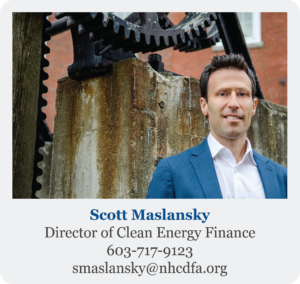Program Overview
CDFA’s Clean Energy Fund invests in energy efficiency and renewable energy projects that reduce costs for New Hampshire businesses, non-profits, and municipalities, that help address New Hampshire’s energy challenges in a fiscally and environmentally responsible manner, that help reduce New Hampshire’s contribution to global climate impacts, and that reduce barriers for equitable access to the many benefits of clean energy.
Capitalized at over $10 Million, CDFA’s Clean Energy Fund merges four individual revolving loan funds dedicated to financing energy-efficiency improvements and clean / renewable energy initiatives into a single program and application process providing low-interest loans along with energy technical assistance and project funding guidance.
Funding for the program comes from a combination of Federal and State sources as well CDFA’s own funds.
Program Objectives
- Offer financing options for New Hampshire businesses, non-profits, and municipalities to implement clean energy projects that:
- Reduce operating costs
- Reduce energy use and its related environmental and climate impacts
- Improve non-energy benefits including: Building durability, occupant comfort and safety, and workplace productivity;
- Increase access to clean energy and its associated benefits for all NH residents.
- Provide technical assistance to prospective borrowers as well as to contractors and partners in all stages of project development;
- Complement CDFA’s grant programs with financing tools and technical support for projects with expected annual energy savings;
- Coordinate with non-CDFA funding sources to enable a creative approach to financing;
- Develop public-private partnerships, de-risking private investment;
- Structure loans to ensure project savings are equal to or greater than annual debt service payments.
- Provide programmatic and underwriting flexibility to support projects benefitting underserved populations, utilizing newer clean energy technology, substantially exceeding the current state energy code, and/or improving community, organizational, or facility resiliency.

